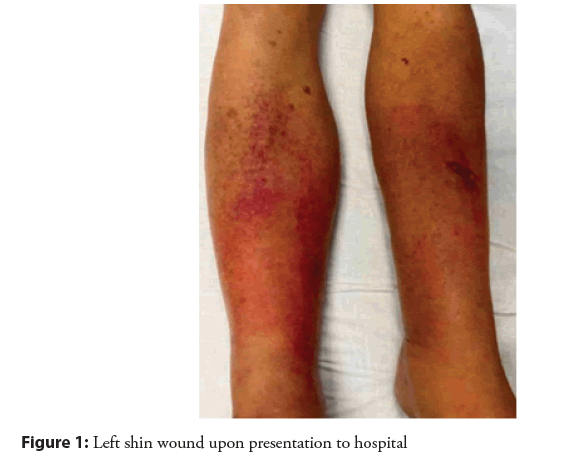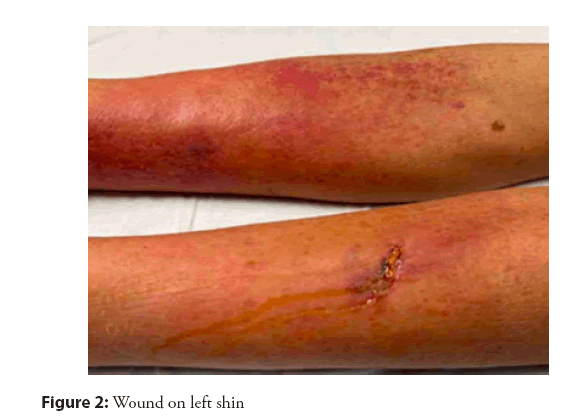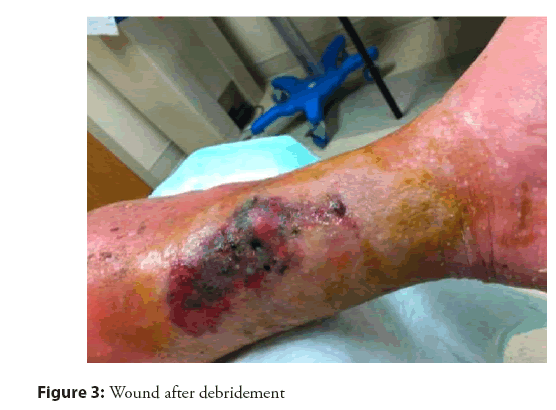Image Article - Interventional Cardiology (2023) Volume 15, Issue 6
Aeromonas bacteremia in a patient with decompensated EtOH cirrhosis
- Corresponding Author:
- James Gore
Department of Internal Medicine, Ochsner Clinic Foundation, New Orleans, United States of America,
E-mail: james.gore@ochsner.org
Received date: 03-Jan-2024, Manuscript No. FMIC-24-124387; Editor assigned: 05-Jan-2024, PreQC No. FMIC-24-124387 (PQ); Reviewed date: 19-Jan-2024, QC No. FMIC-24-124387; Revised date: 26-Jan-2024, Manuscript No. FMIC-24-124387 (R); Published date: 02-Feb-2024, DOI: 10.37532/1755- 5310.2023.15(6).773
Description
Aeromonas hydrophila is a gram-negative rod, aquatic microorganism implicated in clinical disease, including skin soft tissue infections and rarely, bacteremia. In patients with cirrhosis, Aeromonas bacteremia has been associated with higher mortality than bacteremia caused by other organisms [1,2]. The following presents a case of a woman with cirrhosis and lower extremity wound exposed to brackish water, found to have Aeromonas hydrophila bacteremia.
A 50-year-old-woman with EtOH cirrhosis, active EtOH use, ascites, chronic hyponatremia, and HTN presented to outside hospital with painful bilateral LE swelling, found to have an open LE wound (Figures 1-3) and decompensated cirrhosis. Shizuma, et al. [3], was transferred for hepatology, cardiology and general surgery evaluation for concern of necrotizing fasciitis. While on vacation in New Orleans, she incurred a left LE injury causing an open wound in a blackberry bush, which she maintained while dredging for oysters in brackish water. Vitals wnl upon admission. Exam revealed jaundice, bilateral LE edema and erythema, tenderness to palpation, no crepitus, and open wound on anterior left shin. WBC 15 (nl 3.9-12.7), Na 124 (nl 136-145), AST 107 (nl 10-44), ALT 55 (nl 10-44), TB 15 (nl 0.1-1.0), Lactic 4.4 (nl 0.5- 2.2), with MELD 22. CT scan negative for findings consistent with necrotizing fasciitis. Blood cultures grew Aeromonas hydrophila. Cardiac surgery believed presentation more consistent with cellulitis. Hepatology consulted for decompensated cirrhosis c/b Hepatic Encephalopathy (HE) and hyponatremia. Hyponatremia improved with IV albumin and lasix. HE resolved with lactulose and rifaxamin. Infectious Disease consulted and recommended cellulitis treatment with 2 weeks of IV Ceftriaxone and PO ciprofloxacin to cover both Aeromonas and possible underlying Vibrio vulnificus infection [4,5].
Conclusion
In patients with cirrhosis, evaluation of LE wounds may be confounded by baseline LE edema which can be a barrier to clinically evaluating for subcutaneous gas. Although Aeramonas is a rare cause of bacteremia, the increased mortality risk associated for patients with cirrhosis and this infection should be considered during treatment and management. With wound exposure to brackish water and concern for cellulitis, empiric treatment for Vibrio is reasonable.
Ethics Approval and Consent to Participate
Consent was obtained by patient for this case report.
Consent for Publication
Informed consent has been obtained from participant for publication.
Availability of Data and Materials
Not applicable.
Competing Interests
No, I declare that the authors have no competing interests as defined by BMC, or other interests that might be perceived to influence the results and/or discussion reported in this paper.
Funding
None.
Authors’ Contributions
*J.G: Primary/first author, wrote and reviewed the case report; R.E: Helped with intro and conclusion; S.S: Helped write clinical case presentation; N.R: Helped take care of patient in clinical setting; S.B: Helped take care of patient in clinical setting; K.R: Reviewed finished work and made edits; H.J: Reviewed finished work and made edits
Acknowledgements
None.
References
- Yumoto T, Ichiba S, Umei N, et al. Septic shock due to Aeromonas hydrophila bacteremia in a patient with alcoholic liver cirrhosis: A case report. J Med Case Reports. 8: 402 (2014).
[CrossRef] [Google Scholar] [PubMed]
- Chalermrat B, Disaya C. Bacterial infections other than spontaneous bacterial peritonitis in cirrhosis. World J Hepatol. 4: 158-168 (2012).
[CrossRef] [Google Scholar] [PubMed]
- Shizuma T, Tanaka C, Mori H, et al. Investigation of bacteremia due to Aeromonas species and comparison with that due to enterobacteria in patients with liver cirrhosis. Gastroenterol Res Pract. 930826 (2011)
[CrossRef] [Google Scholar] [PubMed]
- Choi JP, Lee SO, Kwon HH, et al. Clinical significance of spontaneous Aeromonas bacterial peritonitis in cirrhotic patients: A matched case-control study. Clin Infect Dis. 47: 66-72 (2008).
[CrossRef] [Google Scholar] [PubMed]
- Rhee JY, Jung DS, Peck KR. Clinical and therapeutic implications of Aeromonas bacteremia: 14 years nation-wide experiences in Korea. Infect Chemother. 48(4): 274-284 (2016).
[CrossRef] [Google Scholar] [PubMed]




